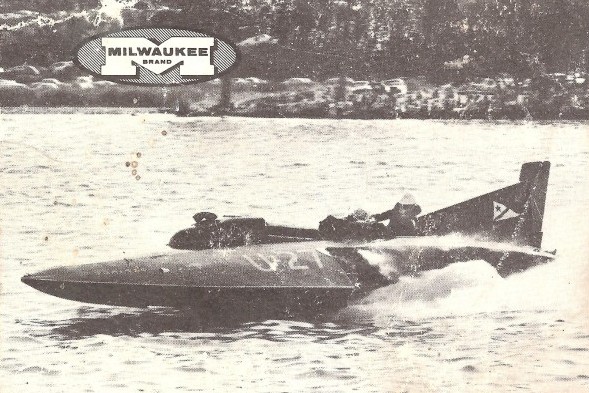
By David Eskenazi and Steve Rudman
Every summer thousands of Puget Sounders flock to Lake Washington to witness — from the shore, rowboats, yachts, cruisers, tug boats, fishing vessels and sail boats — the regional spectacle of unlimited hydroplane racing.
Seattle’s involvement in this eclectic athletic niche started in 1951 because of one man’s obsession, another’s money, and their mutual dependence on each other, although they didn’t always see eye-to-eye.
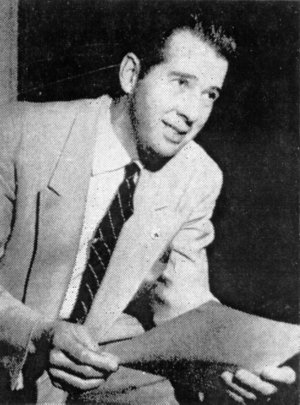
While most thunderboat fans bond with the sport through the risk takers who pilot the boats — Bill Muncey, Ron Musson, Dean Chenoweth, Chip Hanauer and, more recently, Dave Villwock — the real legends are the men who conceive and design the machines. No one ever did this better than a Boeing engineer named Tudor Owen Jones, the individual most responsible for the Seafair hydroplane tradition that thousands enjoy today.
Jones, who once told a reporter, “the only thing I’ve got between my ears is boat building,” first stepped into a water craft in 1926. Over the next three decades, he became consumed with achieving one goal — winning the Gold Cup, the American Power Boat Association’s biggest prize.
To that end, nothing escaped his attention. For years, Jones fixated on the right combination of design and power, the shape, size and location of the rudder, the size of the propeller with respect to gear ratio, the location of the prop, the construction of the fuel tanks, even the design of the drivers seat.
“He was the most creative man in the history of hydroplane racing,” said Tod Steward, Jones grandson, without exaggeration. “He revolutionized the sport. He loved the speed of it.”
Ron Jones, Ted’s son and a renowned boat builder himself, wrote the forward to A Century of Gold Cup Racing, an excellent history by Fred Farley and Ron Harsin. In it, Jones says, ”Remembering back as a young boy, my dad was always either designing, building or driving a race boat — or helping a friend get their boat going to make sure the race to be held on the following weekend would have enough participants.
”Hydroplane racing became his whole life, his dream, and most of his energy was spent building a better boat or fixing the one he had. He might be building a new engine or somehow figuring out how it would go faster.
“Jones conceptualized many of his designs in the middle of the night, often bursting awake to make sketches on a notepad he kept next to his bed.
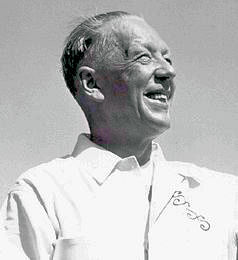
“Not long after Ron’s 14th birthday, Ted showed him a drawing. It depicted an unlimited hydroplane that Ted thought could win the Gold Cup, Harmsworth Cup (British equivalent of the Gold Cup) and set a prop-driven straightaway record. Ted told Ron that the drawing would one day be worth a considerable sum of money.
”His entire life was on that drawing,” Ron continued in his forward to A Century of Gold Cup Racing. “Those three events were what had driven him on for all those years building, designing, racing, starting clubs – all directed towards winning the Gold Cup, bringing the world’s water speed record back to America from England and winning the British Harmsworth.
“That drawing Dad showed me when I was 14 became the design of a three-point hydroplane for Mr. Sayres.”
While Jones had a myriad of design ideas, he lacked the funds necessary to build the kind of hydroplane he envisioned. But in 1947, Jones met Stanley St. Clair Sayres, a World War I aircraft machine-gun mechanic who ran an auto lot in Pendleton, OR., before moving to Seattle, where he became a well-to-do automobile salesman.
Sayers had been fascinated with automobile and boat racing for years, but it wasn’t until 1937, when he acquired a secondhand inboard racer with a 225-cubic inch engine and a three-point hull that could do 90 mph, that his passion for the sport began to peak. Sayres named this boat Slow Motion, ultimately streamlining it to Slo-Mo-Shun.
After Slo-Mo, as it came to be known, burned and sank in 1941, Sayres got another boat, christening it Slo-Mo II. By 1946, Sayres brought out his third iteration, Slo-Mo III. According to hydro historian William L. Worden, “Slo-Mo III could do 96 mph but she could never do better than second place in the local closed-course competitions because she couldn’t accelerate fast enough to make her speed count.”
Jones and Sayres, who met due to their mutual interest in limited hydroplane racing, got to talking. Jones informed Sayres that he had the working design for an extremely fast boat and was seeking a backer. Sayres agreed to put up the money to cover the cost of the 225 Class Slo-Mo IV. The fabulously named Anchor Jensen, owner of Portage Bay’s Jensen Motor Boat Company, agreed to build it.
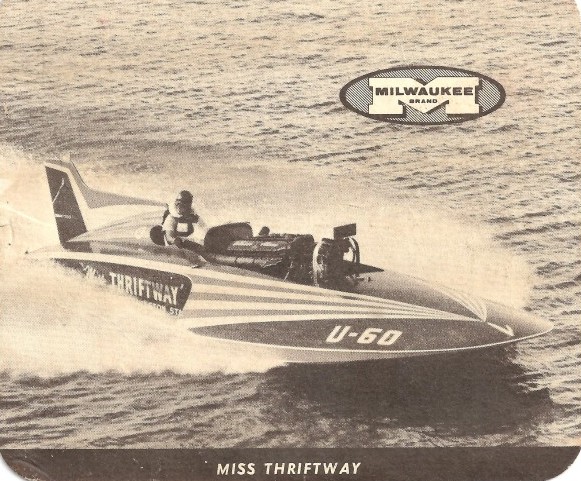
To refine their ideas, Jones, Sayres and Jensen traveled to Detroit to watch that year’s Gold Cup. They had a particular interest in a boat called My Sweetie, a non-prop-riding, “two-step” hydroplane that won the Cup.
Jensen recommended to Sayers that they build a boat similar to My Sweetie. But Jones thought he had a better design, and Sayres accepted Joness suggestion that Slo-Mo IV should be a three-point prop rider, a boat with two sponsons and a propeller.
Construction of Slo-Mo IV commenced at the Jensen Motor Boat Company during the fall of 1948 and followed the basic design that Jones had envisioned 10 years earlier.
Worden described the finished product: ”She was radically different — flat, triangular, designed to rise and ride on two tiny sponsons, which, with the propeller and a bit of the bottom of her main strut, were the only parts to come in contact with the water. For power she was given an Allison aircraft engine with 1,500 horses, almost enough to make her get up and fly . . . the main question still was whether she would swim.”
She would, and Worden described the reaction the first time Jones and Sayres tested Slo-Mo IV on Lake Washington in early 1950: ”She was a spectacular but unloved sight – a roaring skate of a craft that spouted a 30-foot rooster-like tail of water in its wake and scared the daylights out of row-boaters and sailing crews as it zipped past.”
Jones had three racing ambitions: Win the Gold Cup, claim the Harmsworth Cup, and set a straightaway water-speed world record. Jones even promised to repay Sayres for the building costs of Slo-Mo IV if the boat didn’t break the record.
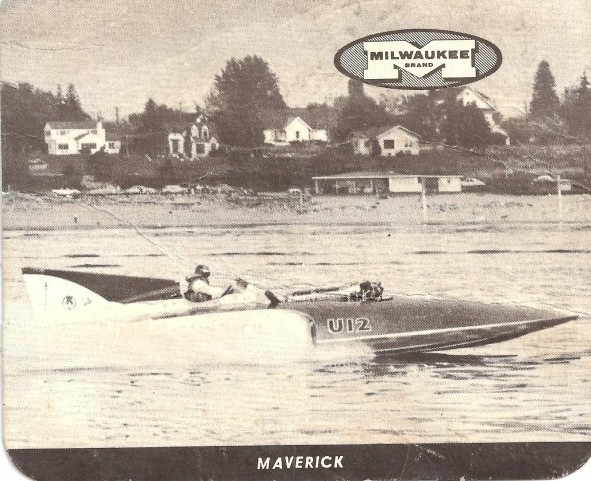
Jones had justifiable faith in his ideas. On June 26, 1950, with Sayres driving and Jones alongside as his riding mechanic, Slo-Mo IV sped through an electronically operated trap off Sand Point (one mile down and one mile back) at an average speed of 160.223 miles an hour, which toppled by more than 18 mph the 11-year-old standard of 141.74, established by Sir Malcolm Campbell’s Bluebird K4 (Campbell set 13 water and land speed records during his career).
When Malcolm Campbell’s son, Donald, also a boat racer, received word of Slo-Mo IV’s time (160.223), he abandoned his own planned attempt at setting a straightaway record, calling it currently hopeless.
”Naturally, Jones told Seattle newspapers, ”the performance of the Slo-Mo-Shun IV in breaking the mile record was gratifying to me, as it has been my ambition since I was 12 years old to design or build the fastest boat in the world.”
After setting the mile straightaway record, Sayres filed an entry to challenge for the Gold Cup, then held in Detroit.
Kent Hitchcock, an American Powerboat Association official from California who had come to Seattle to verify a record if one was made, offered his prediction of Slo-Mo IV’s chances in the Gold Cup.
”Its in the bag, you can quote me on that,” said Hitchcock.
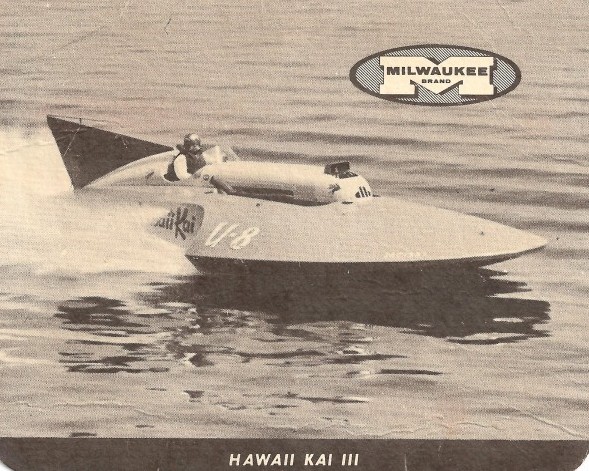
Three months later, Sayres and Jones arrived in Detroit for the 43rd running of the Gold Cup. For this edition, Sayres let Jones pilot the boat with Mike Welch serving as riding mechanic.
Not many (if any) in the Detroit boating community took the Sayres-Jones team, or their outlandish-looking mahogany and red-tailed craft seriously. Slo-Mo IV might, Detroiters argued, have straightaway speed, but no way would it be able to navigate the sharp turns of the Detroit River’s dog-leg course.
Said one newspaper: “Detroit seemed to feel their local armada would have no difficulty dispatching this backyard creation from somewhere out west. They even admitted it may have been fast in the straightaway, but would be a ‘worm in the turns.’”
Eight boats went to the post for the three-heat, 90-mile race, and all that anyone saw of Ted Jones was the back of his head. Slo-Mo IV got a bit of a challenge from My Sweetie through the first two heats, but the defending champion, driven by Lou Fageol, blew an oil line late in the second, finishing her for the day and making the third heat anticlimactic.
Slo-Mo IV won all three heats, setting a race record of 78.217 mph. Although far off the world record of 160.3235 mph that Slo-Mo IV had recorded on Lake Washington June 26, Lake Washington was a one-mile straightaway course vs. the Detroit Rivers dog-leg layout. In addition, ground swells and a six-knot current cut down the speed.
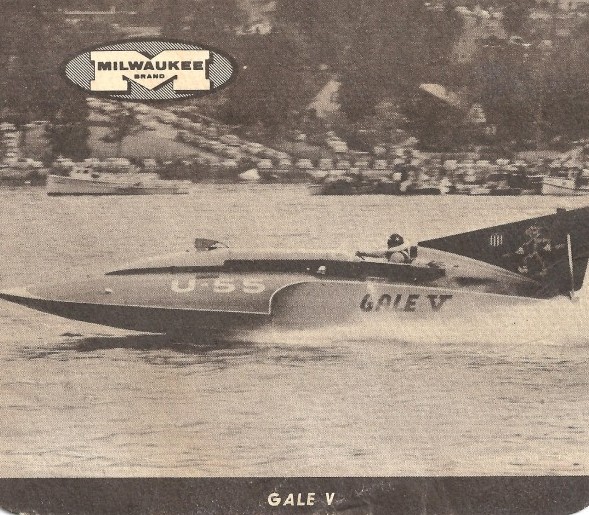
The important point: Slo-Mo IV had bettered the previous Gold Cup record of 75.55 mph set by Skip-a-Long in 1949, had also set a heat record of 80.987 mph, and deposited Detroit, the Gold Cup capital, on its ear. At one point in the race, Jones and Slo-Mo-IV had a one-lap lead on the eventual runnerup, Tempo VI, driven by renowned bandleader and hydroplane enthusiast, Guy Lombardo, the 1946 Gold Cup champion.
“In the 1940s and 1950s, a winning God Cup driver became an instant hero, a folk-hero of sorts,” said Ron Jones. ”Dad finally realized his dream.”
Not quite. But a week after Jones won the Gold Cup, Sayres placed Fageol behind the wheel of Slo-Mo IV, and he took the Hamsworth Cup with an average speed of 95.903 mph, a race record. Now Ted Jones had realized his dream: the straightaway record, the Gold Cup and the Hamsworth Cup — in the span of just three months.
In those days, the Gold Cup winner had the right to select the site for his title defense. Jones, representing the sponsoring Seattle Yacht Club, selected his hometown, marking the first time since the Gold Cup was inaugurated in 1904 that the race would be contested west of Detroit.
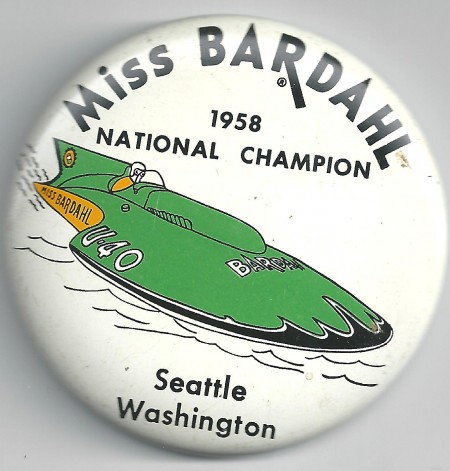
In the year following his Gold Cup win, Jones worked on the design for Slo-Mo IV’s successor, Slo-Mo V. Jones had designed Slo-Mo IV primarily for straightaway racing but, Jones figured, Slo-Mo V would be a more effective competition boat.
Also in the year following Jones’ victory, he and Sayres became Northwest celebrities. As they occupied the sporting limelight, it became clear to civic tub-thumpers that the upcoming hydroplane races (the Seafair Trophy race would follow the Gold Cup by a week) would serve as the perfect promotional centerpiece for the summer’s major tourist attraction, Seattle Seafair. Locals embraced the idea wildly.
On Aug. 4, 1951, more than 100,000 people showed up to witness the first unlimited hydroplane race in Seattle history. The west shore of Lake Washington, from the floating bridge to Seward Park, was crowded from the shoreline to the top of the hill. Countless other thousands watched under overcast skies from the decks of about 500 craft moored east of the race course.
The race, which included 11 entries, went off at 1:30 p.m. following a half-hour wait for the swells to subside. More than 100 newspaper, magazine and newsreel photographers recorded the event.
Jones’ latest creation, Slo-Mo V, Fageol at the wheel, won it by setting a Gold Cup record at 90.4068 mph. Jones finished third in Slo-Mo IV. On the first lap of Heat 1, Slo-Mo V demonstrated acceleration never before witnessed in hydroplane in competition, establishing a three-mile mark of 108.633 mph, which raised the former record by more than 22 mph.
(The 44th running of the Gold Cup included just two heats. Race officials canceled the final heat after Quicksilver of Portland overturned on the straightaway, killing its driver, Orth Mathiot, a Portland tug boat operator, and mechanic Tommy Whitaker, instantly, the first fatalities in Gold Cup history.)
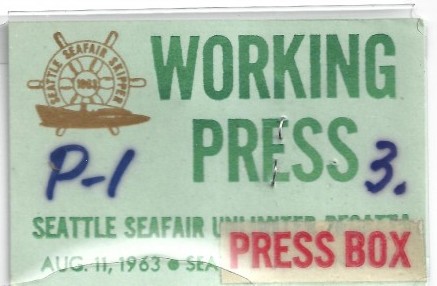
Observed the Seattle Times: ”The triumph of Slo-Mo V is a great tribute to Ted Jones.”
One week later, again on Lake Washington, Jones drove Slo-Mo V to victory in the inaugural Seafair Trophy race. Another 100,000 lined the shores of Lake Washington, and a tradition had taken root.
“The Slo-Mo kind of epitomized professional sports when I was a child,” future Hall of Fame driver Chip Hanauer said in an interview. “In many respects, Slo-Mo-Shun was the first Seattle professional sports franchise, and he (Ted Jones) created it.”
In 1952, Slo-Mo-Shun V went dead in the water, but Slo-Mo IV came through, taking her second Gold Cup victory. Slo-Mo IV won the Gold Cup again in 1953 after Slo-Mo V came up disabled during trial runs. In 1954, Slo-Mo V gave Sayres his fifth consecutive Gold Cup victory, breaking the previous ownership record held by Gar Wood, the first superstar in unlimited history.
Slo-Mo V flipped in 1955 and Slo-M0 VI crashed in 1956. Sayres never lived to see a Slo-Mo VII. He died of a heart attack in September shortly after Slo-Mo VI crashed.
Jones lived to see 90. His legacy extends well beyond his design work with the Slo-Mo series. He also designed Shanty 1 (his personal favorite), Maverick, Miss Thriftway, Miss Wahoo, Hawaii Kai III, probably the best overall race boat of the 1950s, taking the straightaway world record from 178 mph to 187 mph.
(When Ballard-based Ole Bardahl became a hydroplane owner in 1958, he ordered a new, unlimited hull from Ted Jones. The task of constructing it fell to Ted’s son, Ron, whose creation, the U-40, won 27 races, including five Gold Cups and six national championships, between 1957-69. The Miss Bardahl, one of the most popular hydroplanes of all time, won 24 of the 27 races in the 1960s, the most of any boat in that decade.)
Between 1950 and 1966, Ted Jones-designed boats won 75 major races, including 14 Gold Cups, and claimed an unprecedented 10 consecutive National High Point Championships. Between 1950 and 1960, Jones’ unlimiteds raised the world mile straightaway record from 141 to 192 miles per hour.
While Jones organized the Miss Thriftway team for owner Willard Rhodes, after determining that his own driving days were over, Jones offered a young driver who had impressed him the pilots seat in the boat – Bill Muncey’s first big racing break.
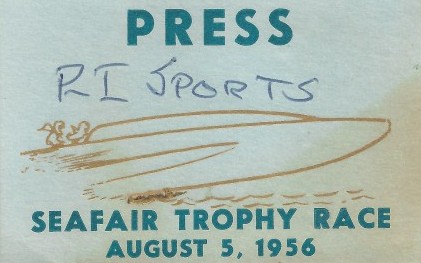
Forty years after Ted Jones won the Gold Cup in Detroit, the stretch of Lake Washington where the hydroplanes run became Ted Jones Race Course. That year (1990), Mayor Norm Rice proclaimed Aug. 2 as Ted Jones Day in Seattle. Today, the original Gold Cup-winning boat, Slo-Mo-Shun IV, is part of the collection of the Museum of History and Industry.
After Jones died in a Des Moines nursing home Jan. 9, 2000, he received numerous tributes from hundreds inside and outside the hydroplane industry. None put his career in better perspective or explained his legacy as well as Hanuer.
“All the boats that are being built and designed today are derivative of his basic design. He set the stage technically for what we’re doing even today.”
————————————
Check out David Eskenazis Wayback Machine Archive. David can be reached at (206) 441-1900, or at seattlesportshistory@gmail.com

22 Comments
Great article!
Steve Sage
Petoskey, MI
It’s great to see someone still appreciates Unlimited Hydroplane Racing! Detroit is a lot less today because of the loss of interest in this sport! Personally….I admire Seattle for its continued interest. I’m a fan and always will be!! The innovators of this sport should remembered and praised for their insight and participation in this sport.
It’s great to see someone still appreciates Unlimited Hydroplane Racing! Detroit is a lot less today because of the loss of interest in this sport! Personally….I admire Seattle for its continued interest. I’m a fan and always will be!! The innovators of this sport should remembered and praised for their insight and participation in this sport.
The hydro’s have a great history, but sadly, nearly all of the drivers who would make up their hall of fame were killed while racing. This bloody history was partially responsible for me losing interest in the sport. That along with the advent of professional sports teams in Seattle made me realize that hydroplane racing was basically a fringe sport, about as relevant as water polo. The fact that over 100,000 people crowded the shores of Lake Washington back in the 50’s to watch the gold cup was not a testament to the popularity of hydroplane racing so much as proof of what a crap sports town Seattle was back then.
As opposed to now, when Seattle is known universally as a sports Goliath. No, there is nothing in Seattle–sports-wise or just in its usual smug passive-aggressive manner–that compares with the roars of the Hydros.
Yeah, the roar of the Hydros … This is a sport where it is not unheard of to have a heat where the winning boat is the only boat that did not stall in the water. This is a sport where the field is usually made up bunch of obsolete, un-sponsored thunder slugs that get beat by the same big sponsor boats every year. This is a sport where most of its greatest drivers were killed while strapped inside their cockpits. This is a sport where at least 90% of its spectators don’t have a clue or a care about who is racing, and who mainly attend to watch the Blue Angels who, BTW, also seem to be losing their relevance in a world where the skies are patrolled by unmanned drones.
Sounds a lot like major league baseball to me, at least with regard to it being typically the same teams every year in the hunt for the championship. As for “90%” of spectators not knowing or caring about who is racing, you also could be describing the Kentucky Derby, Indy 500, and a host of sporting events that typically come-around once a year and thus bring much more with them than just the event. In fact, Seafair is arguably the only local event that occurs here that I feel the least bit of affinity for and I have lived here essentially my entire life. As for the Blue Angels, they are the best part of Seafair. Now what would really be cool would be if they crashed more often, eh?
While MLB and the Indy 500 and perhaps all major sports probably share some of the bad aspects of Hydroplane Racing, none of those sports share them all. Trust me, this sport is uniquely bad.
But the Hydros had their share of golden years. They were the talk of the town for decades — but the time has come for this sport to speed up its half century of fading away. We will always embrace our fond memories of the Thunder Boats, but like the Romans, who eventually had to turn their backs on chariot racing and gladiator fights, we will move on.
What the heck is your problem?
Did a hydroplane run over your dog?
I’m wondering what rock you’ve been living under the past five years, as the racing in the Unlimited ranks has been unparalleled. 2010 and this year have produced some of the closests heats in Seattle history, including the beloved Slo-Mo years.
If you aren’t interested in the sport anymore, that’s perfectly acceptable. Go to a Storm game or something. But shut the hell up.
Opinions are like genitalia, everyone – well, maybe thats not a good comparison – but I respect your adolescent enthusiasm for Unlimited Hydroplane Racing. And don’t let anyone change that very limited mind of yours. It would be like trying to convince a Curling fan that their sport sucks. I was thinking that perhaps I had been a bit callous. – maybe I should check it out again — pack up the family and visit the Hydro Museum in Kent …
But then you dump on the Storm as if not being interested in UHR was not masculine or something. Some one needs a timeout, mister.
This is a great article, I would like to see more about the great races, drivers. and boats.
Fortunately, the Mariners” herculean efforts should be rewarded next year. They will climb out of the cellar. Houston is joining the division.
Is it too soon to point out that most of Jack’s trades have been horrible once the data is in?
All he has to show for Morrow now is a couple low level prospects. With Smoak a bust Beaven is what he got for Cliff Freakin Lee? A couple worthless prospects for Fister? Montero may pan out, but he sure doesn’t look like an everyday catcher and his bat needs to improve to be a first baseman
Retrospect is always 20/20. As far as Zduriencik’s trades are concerned, I’ve got mixed emotions. However, at the time of the trades Smoak looked like a future big league hitter at a young age and Lee was in a contract year with a team that was out of the playoff race. I’m sorry Eric K, but you’re missing the big picture here. Many of the players we’ve traded in the past were in contract years, or we were overstaffed in certain positions. I hate to say the same line we’ve been saying for the past 10 years, but, we’re rebuilding. Unfortunately, sometimes players you expect to get better or reach their potential…don’t. Therefore, I wouldn’t place all blame on Jack for our current situation; rather a combination of bad luck, lack of veteran leadership, inconsistency in coaching, as well as uninterested ownership. Looking ahead (an all to familiar tagline), I think that our minor league pitching staff is looking very impresive, with some bats here and there, and that we should expect nothing less than a wild-card run next year.
We have been “rebuilding” for at least 80 percent of the last 35 years. And contrary to the way SportsPress Northwest likes to characterize it, our performance over that time has been substantially below “mediocre.”
Nobody’s missing the big picture here: same old same old, including the reasons why the team sucks, still, and just can’t get rolling– it’s always any fault possible except competence in the FO. They don’t care about winning baseball games except to keep the franchise afloat until they sell for monster franchise-appreciation profit. No passion for, sense of, sensibility about or respect towards the game and the gem they’ve got some obligation to nurture and care for: A city’s major league baseball team.
Teams can rebuild, and can win ball games and can make baseball decisions; can be a matter of civic pride, can be .. we can be anything but a perennial laughingstock, if motivated at the top to do so. That’s really not debatable.
We were a laughingstock for most of the Kingdome years, and the “ballpark” made it worse. The big hope came with the 95team, new ballpark, the building (not Rebuilding) , Pinella/Gillick were doing — which came to an abrupt end with Lincoln’s idiocy and “insubordination” rant when baseball people wanted –how ironic– baseball decisions. The new stadium has not served the cause of baseball, nor served anybody well except the soon-to-be-richer-yet-when-they-sell ownership group, all cowards before Lincoln in baseball matters– or duplicitous in the extreme.
Making excuses for them– prospects don’t turn out, things happen, bad free agent market, poor draft year, etc etc– just empowers these guys to continue foisting their ‘rebuilding’ mantra on ticket buyers.
Boycott, don’t excuse.
Hey wecouldabeensomebody, I wouldn’t go that far. Jack Z’s stock went up a little today, by not trading Vargas. Felix might have some hope that we aren’t a farm club for the Yanks. No, the A’s aren ‘t worried about the Mariners, but lets look again in a couple weeks. A telling road trip awaits, the Yanks, Baltimore and the Angels. Ford a .500 record there, there may be hope for next year. .500 would be a super successful year, dude!
Carp at 1st, Ackley hitting, and the other chips contributing may offer some hope!
Fairmont, it all depends on your perspective. The Mariners have won nine of 11, and they haven’t been to the playoffs in 11 years.
The M’s rebuilding project started three years ago when Zduriencik began overhauling the minor league system and focusing on accumulating as many legit prospects as possible. That’s not a guarantee of success, but when you don’t have money to throw around at free agents like the Yankees, Red Sox or Cubs, it’s the smarter way to retool your franchise even though it takes longer to bear fruit.
Nobody said this was going to be a breakthrough season and it’ll be much the same in 2013. To me, 2014 is when we’ll really know where this is all going. If you’re looking for instant gratification, be a Miami Heat fan.
Radio, how about a little gratification?
Isn’t a six-game winning streak a little gratifying to you, Art? Just remember (and I probably say this too often) that the Mets were 73-89 one year before winning the World Series…and that had been their best year to that point.
wecoulda, the depth and richness of your sarcasm has won first prize in the Snark of the Month contest. Please pick up your first-place bowl of sunshine from the Mariners front office after the playoffs.